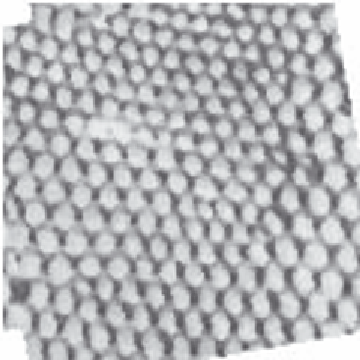Image Processing Reference
In-Depth Information
white and black points to appear within an image. It can also arise when rotating an image,
when points remain unspecified by a standard rotation operator (Appendix 1), as in a
texture image, rotated by 10° in Figure
3.21
(a). When a median operator is applied, the salt
and pepper noise points will appear at either end of the rank ordered list and are removed
by the median process, as shown in Figure
3.21
(b). The median operator has practical
advantage, due to its ability to retain edges (the boundaries of shapes in images) whilst
suppressing the noise contamination. As such, like direct averaging, it remains a worthwhile
member of the stock of standard image processing tools. For further details concerning
properties and implementation, have a peep at Hodgson (1985). (Note that practical
implementation of image rotation is a computer graphics issue, and is usually by
texture
mapping
; further details can be found in Hearn (1997)).
(a) Rotated fence
(b) Median filtered
Figure 3.21
Illustrating median filtering
Finding the
background
to an image is an example application of statistical operators.
Say we have a sequence of images of a walking subject, and we want to be able to find the
background (so we can then separate the walking subject from it), such as the sequence of
images shown in Figures
3.22
(a)-(f) where a subject is walking from left to right. We can
average the images so as to find the background. If we form a
temporal average
, an image
where each point is the average of the points in the same position in each of the six images,
then we achieve a result where the walking subject appears to be in the background, but
very faintly as in Figure
3.22
(g). The shadow occurs since the walking subject's influence
on image brightness is reduced by one-sixth, but it is still there. We could of course use
more images, the ones in between the ones we already have and then the shadow will
become much fainter. We can also include spatial averaging as in Section 3.3.2, to further
reduce the effect of the walking subject, as shown in Figure
3.22
(h). This gives
spatiotemporal
averaging
. For this, we have not required any more images, but the penalty paid for the
better improvement in the estimate of the background is lack of detail. We cannot see the



















